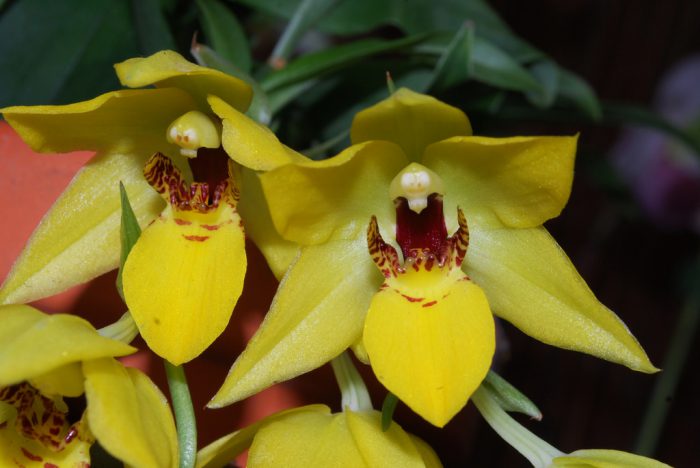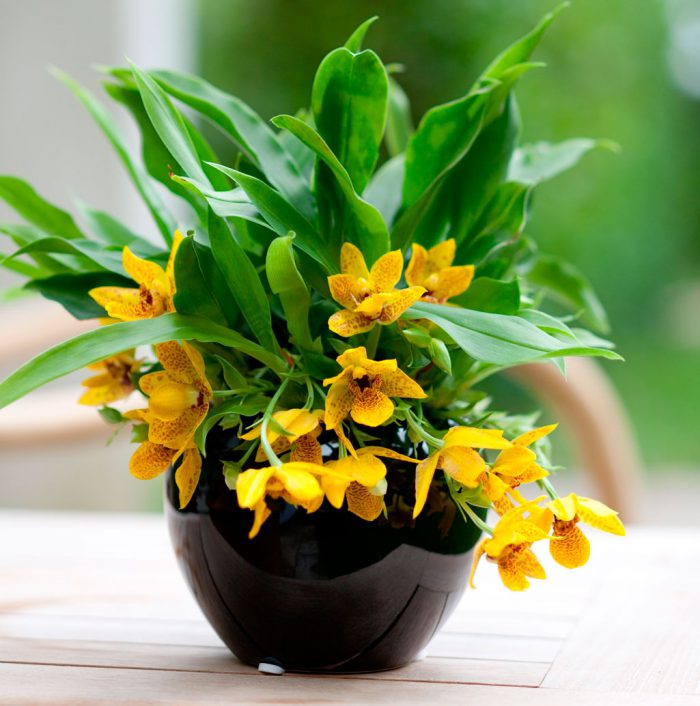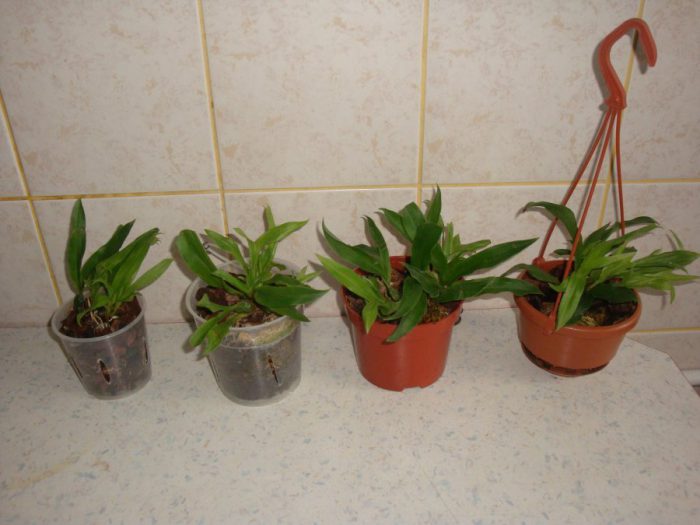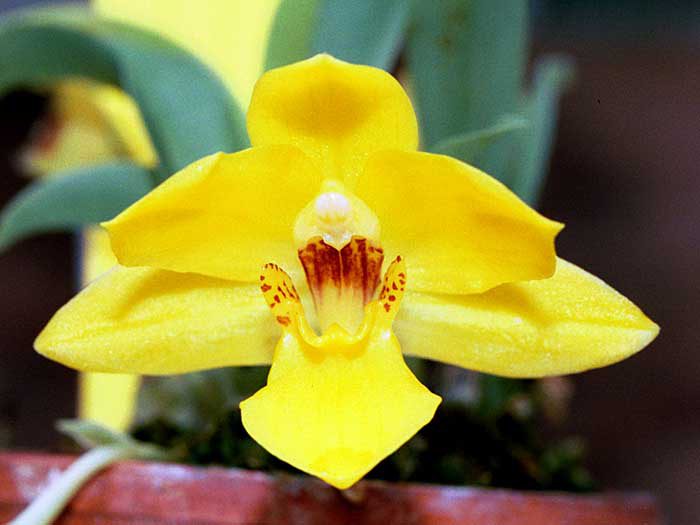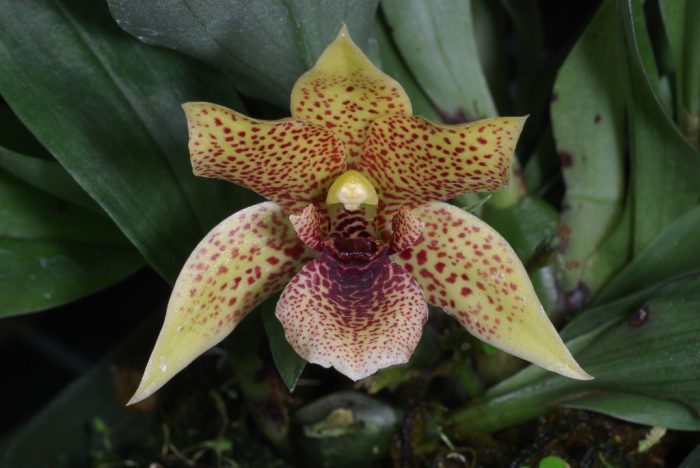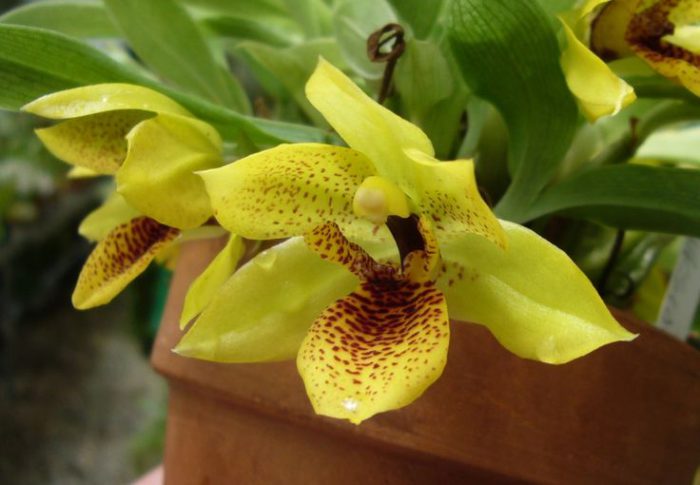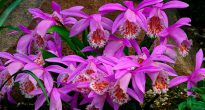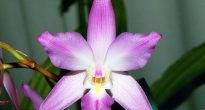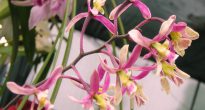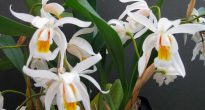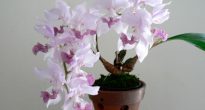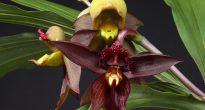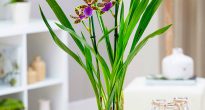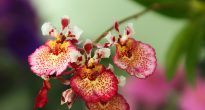Small genus exchanging (Promenaea) is directly related to the orchid family. This genus unites 14 species of miniature epiphytic plants that can be found in nature only in some areas of the tropical mountain forests of Central and Southern Brazil.
Such a plant has a close connection with the genus. zygopetalum, and therefore it is often ranked among the latter and at the same time is called accordingly, for example, yellow zygopetalum (Zygopetalum citrinum). However, in fact, this plant has long been isolated into a separate genus.
This genus is characterized by a compact size, as well as a simpoidal type of growth. The flower has a rhizome (a creeping modified stem), as well as small pseudobulbs with an ovoid, slightly flattened shape. Pseudobulbs seem to sit on wide leaf petioles located below. The second pair of leaves (petiolate) grows from the top of the pseudobulb. Rather thin broadly lanceolate leaves reach a length of 7 to 10 centimeters. They are painted in pale green or pale greenish-gray; on the surface of the leaf plate, veins with a darker color are clearly visible. At the base of the pseudobulbs, short peduncles grow in the lower leaf axils. As a rule, their length does not exceed the height of the plant itself and it is often equal to 5-10 centimeters. On the peduncle there can be 1 or 2 pronounced zygomorphic fragrant flowers with a diameter of 4 to 5 centimeters. The color depends on the species. So, a flower can be pure yellow or with a variety of transversely spaced stripes or specks of a burgundy hue. 3 sepals (sepals, which are often confused with petals) are oval or lanceolate. 2 petals (petals) lying opposite each other, as a rule, practically do not differ from sepals either in shape or color. The lip (the 3rd modified petal) is three-lobed, and it is similar to a small scapula, which has 2 lateral, vertically positioned, limbs. A slightly curved, large column in some species is equal in size to the lip. As a result of the fact that at the base of the lip there is an uneven small outgrowth, together with the lateral parts, a semblance of an "animal mouth" is formed, the throat is opened wide enough. Blooms for a relatively long time, about 3-4 weeks, and sometimes up to 8 weeks.
Caring for an exchange orchid at home
In indoor conditions, both experienced flower growers and beginners can grow this kind of orchid, and that's all, because this flower is distinguished by its unpretentiousness.
Illumination
A fairly light-loving plant that prefers bright, but diffused lighting. However, it feels fine even in not very large partial shade. When placing a flower, it is recommended to give preference to oriental windows. When placed on other windows, it is required either to shade from direct rays of the sun, or supplementary lighting with specialized phytolamps.
Supplementary lighting with phytolamps must be provided for such an orchid in autumn and spring. The fact is that daylight hours all year round should have a duration of at least 10-12 hours.
Temperature regime
This plant requires a cool temperature regime and also has a well-defined dormant period. So, in the warm season, it grows normally and develops at temperatures from 16 to 22 degrees, and in the cold season - from 12 to 15 degrees. In order for the laying of flower buds to be successful, the flower needs a difference in daily temperatures, which should be approximately equal to 5-10 degrees.
In the warm season (from mid-May to mid-September), experts advise moving the flower to the street (to the garden, to the balcony), but at the same time the threat of frost at night should be completely absent. It is easiest here to provide the required daily temperature difference. And also very useful for the promenade and the fresh air itself, which makes it healthier, stronger and more enduring.
Earth mix
Since this plant is an epiphyte, it can be grown on a block, but an ordinary flower pot is also suitable for this, which should be filled with sphagnum and large pieces of pine bark, they should be taken in approximately equal proportions. With this mixture, you need to fill a transparent plastic pot with additionally perforated walls (to improve aeration of the root system).
It is also recommended to use a rather large piece of pine bark as a block. On its surface, you need to fix the roots, having previously created a "pillow" of sphagnum. The roots should also be covered with moss from above to prevent them from drying out quickly.
How to water
Water the plant only after the bark is completely dry. To do this, use extremely soft, filtered water, which should not be colder than room temperature (not higher than 40 degrees). How often this type of orchid needs to be watered depends on the environmental conditions. So, if the room is cool enough, then the bark will dry out more slowly, which means that watering will need to be done less often.
Experts advise to water by immersion method. To do this, the block or container is lowered into a basin filled with water for about a third of an hour.
Humidity
A flower grown on a block needs high air humidity (about 60 percent or more). If there is no orchidarium, then a small household steam generator should be used to increase the humidity in the room, and it should be placed in the immediate vicinity of the plant.
An orchid grown in a pot is able to tolerate low air humidity in city apartments quite calmly, but in order for it to feel more comfortable, it is recommended to systematically moisten its foliage from a sprayer using lukewarm soft water.
Transplant features
You need to transplant the exchange only if necessary. For example, when the container or block becomes cramped, as well as when the substrate is salinized or decomposed.
It is best to transplant at a time when young pseudobulbs begin to develop their own root system.
Fertilizer
You need to fertilize the plant during its intensive growth 1 time in 2 or 3 weeks.To do this, use a special complex fertilizer for orchids, while it is necessary to take 1/3 or ¼ of the dose recommended on the package. Top dressing should be alternated with foliar, while foliage should be sprayed with water, with fertilizer dissolved in it.
Dormant period
This genus of orchids differs from the rest in that it has 2 rest periods at once. The first one is observed in winter, and it comes after young sprouts are formed, and also when new pseudobulbs are slightly rounded. At this time, the exchange needs coolness, as well as very poor watering (you can only spray the flower from time to time). The end of the dormant period is associated with the appearance of a peduncle. From this moment on, the flower is looked after, as in the summer.
After the flowering is over, the 2nd dormant period will begin, during which the plant should rest well. At this time, he must be looked after in the same way as in winter. This period is fairly short, 2 to 3 weeks.
It happens that young pseudobulbs appear in a plant that has not yet faded. In this case, the 2nd rest period is not needed. If it is not there for several years in a row, this will lead to the fact that new growths will grow weaker from year to year, and flowering will not be so abundant, and then completely stop.
Reproduction methods
In room conditions, the exchange, as a rule, is propagated by division. It should be remembered that on each section there should be 3 adult pseudobulbs, which should have well-developed roots.
In very rare cases, a baby is formed on the upper part of a mature pseudobulb, which can later be separated and planted separately.
In industrial conditions, seeds are used for reproduction, as well as the meristem method (cloning).
Diseases and pests
Most often settles on foliage spider mite... When it is found, the orchid needs to arrange a warm shower (about 45 degrees), while the leaves must be thoroughly washed.
It is resistant to diseases, but at the same time, with inadequate care, the plant quickly turns yellow and leaves fly around, or their tips turn black. Such unpleasant consequences can lead to:
- too high air temperature;
- too high humidity;
- frequent overdrying;
- salinization of the substrate;
- poor or vice versa intense lighting;
- hard water used for irrigation.
Main types
Most types of promenades are grown at home, which, as a rule, differ only in color and shape of the corolla.
Exchange golden yellow (Promenaea xanthina)
This type is most common among Russian flower growers. The tetrahedral, oval-shaped pseudobulbs reach 2 centimeters in height and 1.5 centimeters in width. The sepals and petals are pure yellow in color, and on the base of the lip and the surface of the lobes, as well as on the inner part of the column, there are many specks of burgundy color.
Promenaea xanthina var. citrina is a golden yellow promenade with a pure yellow color. It happens that this form is attributed to the species Promenaea citrina, which in fact does not exist.
Promenaea stapelioides (Promenaea stapelioides)
It has a very impressive appearance. So, the inner surface of the column, as well as the lips, are painted in a dark purple color, and along the edges they have small light specks. The petals and sepals of a broad-lanceolate shape are painted in a yellow tint, and on their surface, as well as on the lateral parts of the lip, there are many uneven, transversely located, burgundy stripes. The upper part of the column is pure yellow in color.
Exchange microptera (Promenaea microptera)
It is the smallest plant of the genus. It also stands out among other species with its unusual corolla shape. The length of the peduncles ranges from 4 to 5 centimeters, while the diameter of the flowers is only 4 centimeters.Narrow, reed-shaped sepals and petals have a yellow-lemon color. On the surface of the lip (from its base to the middle) there are quite large patches of burgundy color, and on the lateral parts of the lip and on the base of the column there are strokes of the same color shade. The petals, strongly raised to the upper sepal, form angles with it equal from 20 to 30 degrees. In this case, the lower sepals are directed downward, as a result of which an acute angle forms between them.
Freckled Promenaea (Promenaea lentiginosa)
Has the appearance corresponding to the name. Broad-lanceolate yellow sepals are slightly irregular. On their surface are sparse dots of burgundy color and very small size. But on the surface of the lip and obovate petals there is a huge number of freckle spots. Such spots at the base of the lip are larger, and the inner part of the column has a pure burgundy color.
Promenaea paranaensis
This species is distinguished by short peduncles from 2.8 to 3.5 centimeters, while the diameter of the flowers is standard - about 4.5 centimeters. Long sepals and petals, pointed at the end, are ovoid. On the surface of the lemon-yellow corolla, burgundy spots flaunt. At the same time, on the sepals, or rather in their lower part, there are small spots, and on the petals and lip there are large and there are a lot of them.

